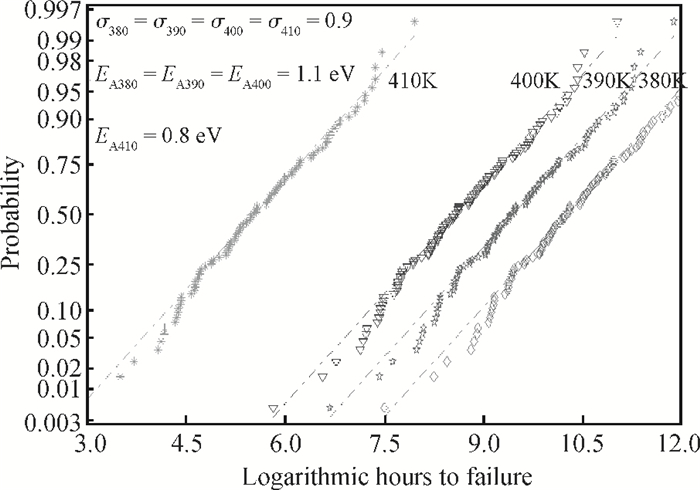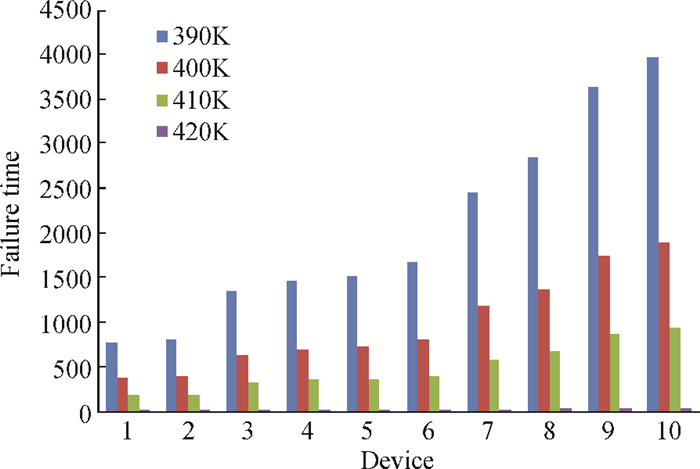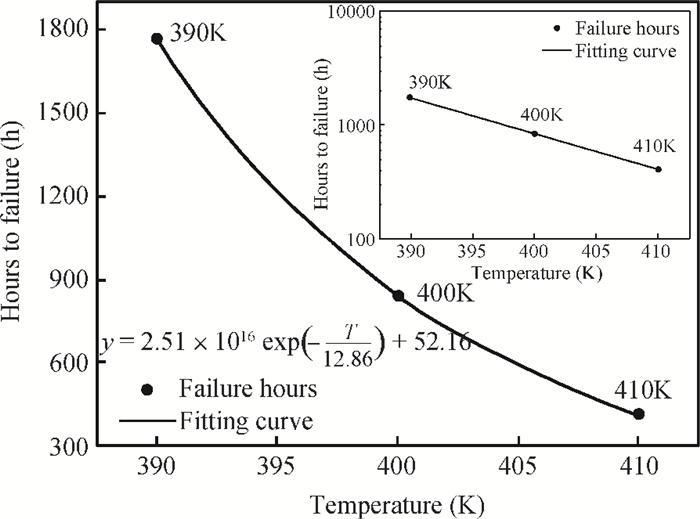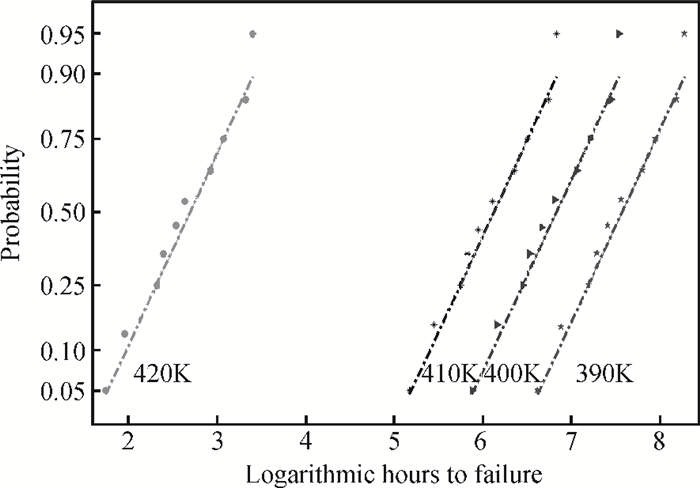| Citation: |
Chunsheng Guo, Yanfeng Zhang, Ning Wan, Hui Zhu, Shiwei Feng. Identifying the failure mechanism in accelerated life tests by two-parameter lognormal distributions[J]. Journal of Semiconductors, 2014, 35(8): 084010. doi: 10.1088/1674-4926/35/8/084010
****
C S Guo, Y F Zhang, N Wan, H Zhu, S W Feng. Identifying the failure mechanism in accelerated life tests by two-parameter lognormal distributions[J]. J. Semicond., 2014, 35(8): 084010. doi: 10.1088/1674-4926/35/8/084010.
|
Identifying the failure mechanism in accelerated life tests by two-parameter lognormal distributions
DOI: 10.1088/1674-4926/35/8/084010
More Information
-
Abstract
The failure mechanism stimulated by accelerated stress in the degradation may be different from that under normal conditions, which would lead to invalid accelerated life tests. To solve the problem, we study the relation between the Arrhenius equation and the lognormal distribution in the degradation process. Two relationships of the lognormal distribution parameters must be satisfied in the conclusion of the unaltered failure mechanism, the first is that the logarithmic standard deviations must be equivalent at different temperature levels, and the second is that the ratio of the differences between logarithmic means must be equal to the ratio of the differences between reciprocals of temperature. The logarithm of distribution lines must simultaneously have the same slope and regular interval lines. We studied the degradation of thick-film resistors in MCM by accelerated stress at four temperature levels (390, 400, 410 and 420 K), and the result agreed well with our method. -
References
[1] Zhang C H, Wang Y S, Chen X, et al. A comprehensive review of accelerated life test. Journal of China Ordnance, 2005, 1(2):213 http://kns.cnki.net/KCMS/detail/detail.aspx?filename=baxy200502017&dbname=CJFD&dbcode=CJFQ[2] Hu J M, Barker D, Dasgupta A, et al. Role of failure-mechanism identification in accelerated testing. IEEE Reliability and Maintainability Symposium, Nevada, Las Vegas, 1992:181 http://ieeexplore.ieee.org/xpls/abs_all.jsp?arnumber=187820[3] Guo C S, Xie X S, Ma W D, et al. A failure-mechanism identification method in accelerated testing. Chinese Journal of Semiconductors, 2006, 27(3):560 http://www.oalib.com/paper/1523033[4] Nelson W. Analysis of accelerated life test data-part Ⅰ:the Arrhenius model and graphical methods. IEEE Trans Electrical Insulation, 1971, EI-6(4):165 doi: 10.1109/TEI.1971.299172[5] Nogueira E, Vazquez M, Mateos J. Accelerated life test of high luminosity AlGaInP LEDs. Microelectron Reliab, 2012, 52(9/10):1853[6] Kang J M, Kim J W, Choi J H, et al. Life-time estimation of high-power blue light-emitting diode chips. Microelectron Reliab, 2009, 49(9-11):1231 doi: 10.1016/j.microrel.2009.07.052[7] Pan X X, Huang X K, Chen Y X, et al. Connotation of failure mechanism consistency and identification method for accelerated testing. IEEE Prognostics and System Health Management Conference, Shenzhen, China, 2011:1 http://ieeexplore.ieee.org/document/5939514/[8] Sun Z L. A condition for constant failure mechanism. Electronic Product Reliability and Environmental Testing, 2008, 26(4):6 http://en.cnki.com.cn/Article_en/CJFDTOTAL-DZKH200804005.htm[9] Meeker W Q, Escobar L A, Lu C J. Accelerated degradation tests:modeling and analysis. Technometrics, 1998, 40(2):89 doi: 10.1080/00401706.1998.10485191[10] Kang T H, Chung S W, Yun W Y. An analysis of accelerated performance degradation tests assuming the Arrhenius stress-relationship. APJOR, 2008, 25(6):847 doi: 10.1142/S0217595908002061?journalCode=apjor[11] Zhang J P, Liu F, Liu Y, et al. Life prediction for white OLED based on LSM under lognormal distribution. Solid-State Electron, 2012, 75:102 doi: 10.1016/j.sse.2011.12.004[12] Sun Z L. Hypothesis testing for constant failure mechanism. Electronic Product Reliability and Environmental Testing, 2009, 27(2):1 http://en.cnki.com.cn/Article_en/CJFDTotal-DZKH200902005.htm[13] Gong Z, Gaevski M, Adivarahan V, et al. Optical power degradation mechanisms in AlGaN-based 280 nm deep ultraviolet light-emitting diodes on sapphire. Appl Phys Lett, 2006, 88:121106 doi: 10.1063/1.2187429[14] Gouno E, Deleuze G, Brizoux M, et al. Bayesian approach of failure rate estimation in field conditions through accelerated testing. IEEE ECTC, Orlando, America, 1993:116 https://www.mendeley.com/research-papers/bayesian-approach-failure-rate-estimation-field-conditionsnthrough-accelerated-testing/[15] Trevisanello L, Meneghini M, Mura G, et al. Accelerated life test of high brightness light emitting diodes. IEEE Trans Device Mater Rel, 2008, 8(2):304 doi: 10.1109/TDMR.2008.919596[16] Li Z G, Song Z C, Sun D P, et al. GaAs MESFET's reliability and new method of rapid evalu ation. Chinese Journal of Semiconductors, 2003, 24(8):856 http://en.cnki.com.cn/Article_en/CJFDTOTAL-BDTX200308015.htm[17] Chang M H, Das D, Varde P V, et al. Light emitting diodes reliability review. Microelectron Reliab, 2012, 52:762 doi: 10.1016/j.microrel.2011.07.063[18] Suk J B, Paul H K. Degradation models. In: Encyclopedia of statistics in quality and reliability. John Wiley & Sons, Ltd, Published Online, 2008. DOI: 10.1002/9780470061572.eqr123 -
Proportional views





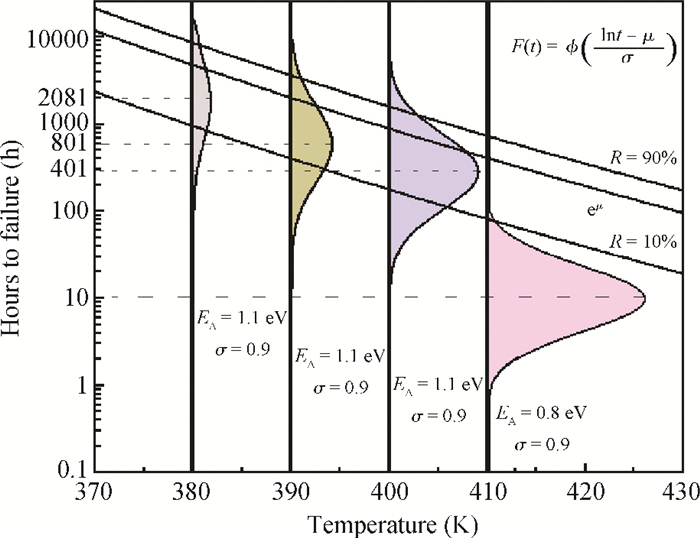
 DownLoad:
DownLoad:
